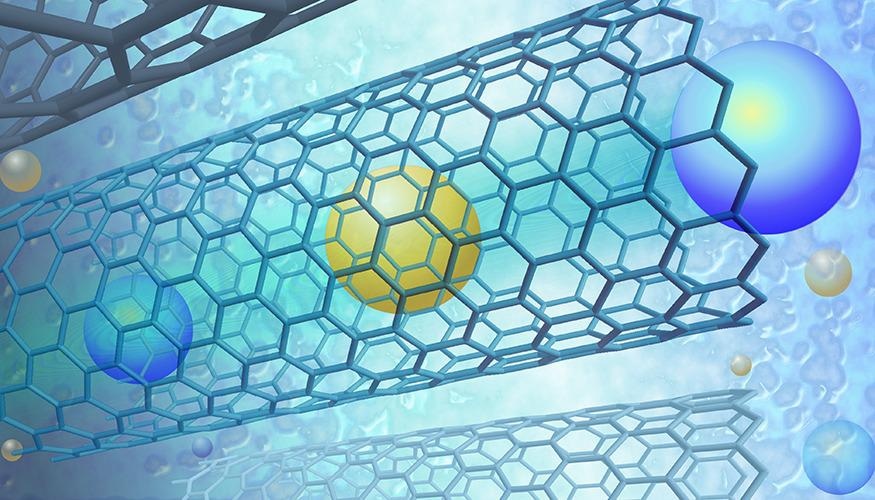Jan 8 2021
Scientists from the Lawrence Livermore National Laboratory have found that ultra-rapid dialysis processes could be achieved by carbon nanotube membrane pores, resulting in considerably reduced treatment time for patients undergoing hemodialysis.
 Artistic rendering of fast ion permeation inside single-walled carbon nanotubes. Small ions such as potassium, chloride, and sodium permeate through the inner volume of nanometer-wide carbon nanotubes at rates that surpass diffusion in bulk water by an order of magnitude. Image Credit: Francesco Fornasiero/Lawrence Livermore National Laboratory.
Artistic rendering of fast ion permeation inside single-walled carbon nanotubes. Small ions such as potassium, chloride, and sodium permeate through the inner volume of nanometer-wide carbon nanotubes at rates that surpass diffusion in bulk water by an order of magnitude. Image Credit: Francesco Fornasiero/Lawrence Livermore National Laboratory.
In manmade and biological processes, the potential to isolate molecular components in complex solutions is very important. One way to do this is to apply a concentration gradient across a porous membrane. This method fuels molecules or ions that are smaller in comparison to the pore diameters from one side of the porous membrane to the other, while preventing anything that is too large to accommodate through the pores.
In nature, biological membranes, like those in the liver or kidneys, carry out complex filtrations and, at the same time, maintain a high throughput. But synthetic membranes usually struggle with a familiar trade-off between permeability and selectivity. The same material characteristics that control what can and cannot travel via the membrane inexorably decrease the speed at which filtration can take place.
In an unexpected finding published in the Advanced Science journal, the team from the Lawrence Livermore National Laboratory discovered that carbon nanotube pores (that is, graphite cylinders that have thousands of times smaller diameters than a single strand of human hair) may offer a solution to the tradeoff between permeability and selectivity.
Whenever a concentration gradient is used as a driving force, tiny ions, like sodium, potassium, and chloride, tend to diffuse through these small pores at rates that are more than an order of magnitude faster when compared to traveling in bulk solution.
"This result was unexpected because the general consensus in the literature is that diffusion rates in pores of this diameter should be equal to, or below what we see in bulk."
Steven Buchsbaum, Study Lead Author, Lawrence Livermore National Laboratory
Francesco Fornasiero, the principal investigator on the project, added, “Our finding enriches the number of exciting and often poorly understood nanofluidic phenomena recently discovered in a-few-nanometer confinement.”
According to the researchers, the study holds major implications in many technology domains. Membranes that use carbon nanotubes as transport channels could allow for ultra-rapid hemodialysis processes that would considerably decrease the treatment time.
Likewise, the time and cost involved for purifying proteins and other similar biomolecules, and also for recovering useful products from electrolyte solutions, can be considerably decreased.
Improved ion transport in tiny graphitic pores could allow high-power-density supercapacitors even at pore sizes almost close to those of the ions.
To conduct these analyses, the researchers manipulated previously designed membranes that enable transport to take place only via the hollow interior of aligned carbon nanotubes with a diameter of only a few nanometers.
With the help of a customized diffusion cell, the team applied a concentration gradient across these membranes and quantified the transport rate of water and various salts.
"We have developed rigorous control tests to make sure there was no other possible explanation of the recorded large ion fluxes, such as transport occurring through leaks or defects in our membranes."
Steven Buchsbaum, Study Lead Author, Lawrence Livermore National Laboratory
To find out how this behavior takes place, the researchers sought the help of many experts from the Lawrence Livermore National Laboratory. Anh Pham and Ed Lau applied computational simulations and April Sawvel utilized nuclear magnetic resonance spectroscopy to investigate the movement of ions within the carbon nanotubes.
The researchers effectively ruled out many potential explanations and made the picture clearer. But a comprehensive, quantitative knowledge of the visualized transport rates is still under development.
Others who contributed to the study include Melinda Jue, Chiatai Chen, Eric Meshot, Sei Jin Park, Marissa Wood and Kuang Jen Wu from Lawrence Livermore National Laboratory and Camille Bilodeau from Rensselaer Polytechnic Institute.
The study was funded by the Chemical and Biological Technologies Department of the Defense Threat Reduction Agency as part of the “Dynamic Multifunctional Materials for a Second Skin D[MS]2” program.
Journal Reference:
Buchsbaum, S. F., et al. (2020) Fast Permeation of Small Ions in Carbon Nanotubes. Advanced Science. doi.org/10.1002/advs.202001802.